七年级英语 公开课教学设计
七年级英语优秀教学设计(通用8篇)

七年级英语优秀教学设计(通用8篇)七年级英语优秀教学设计(通用8篇)作为一位兢兢业业的人民教师,常常要写一份优秀的教学设计,教学设计是把教学原理转化为教学材料和教学活动的计划。
我们应该怎么写教学设计呢?以下是小编精心整理的七年级英语优秀教学设计,仅供参考,大家一起来看看吧。
七年级英语优秀教学设计篇1Unit3. Why do yu like koalas?The first periodⅠ.Teaching Aims and Demands1.Knowledge Objects.1)Key vocabularykoala tiger elephent.dolphin panda lion penguin giraffe zoo cute map smart2)Target languageLet’s see the pandas.Why do you like see the tigers?Because they are cute.2.Ability Objects:1)Train students’abilities of listening and speakng.2) Enable and help the students to learn how to listen to and talk about animals.3.Moral Object:It is very important for everyone to love the nature and protect animals .The earth is our home and animals are our friends..It is our duty to love the nature and protect enviroment.Ⅱ Teaching Key and Difficult Points1)Describe the animals using the words and the target language.2)Get students to learn “Why questions”, “Because answers” a nd the adjectives of quality.Ⅲ.Teaching methods1)Watching and describing methods2) Oral practicing method.Ⅳ.Teaching Aids:1)objects and some pictures.2)A recorder and computerⅤ.Teaching proceduresStep1.Warming up1) Play the tape,get the students to listen to music of animals2) Play a guessing game.T: Listening to the voices of animals.What kinds of animals are they?3) Show some pictures about animals after guessing and talk about animals.T: Look,there is a big zoo in our city There are many animals init.Do you want to see the animals in the zoo?Let’s go into thezoo.What kind of animals can you see?Step2.Present the new words1) T: Look. What is this in Chinese?Ss:“考拉”T: What is this in English?Do you know?Ss: NoT: It is a koala. Read after me K-O-A-L A, koala.2)Show some new words in the pictures.and teach students to learn them.:koala tiger elephent.dolphin panda lion penguin giraffezoo cute map smartStep3. Practice the new words(1a)1)Get students to read the words in 1a2)Match the words with the animals in the oictures.3)After that check the answers.Step4. Task1) Look at the pictures of animals and describe the animals like this. T: Let’s see the pandas .Do you like them?S1: Yes.I like them very much.T: Why do you like them?S1: Because they are cute .Let’s see the lions.T: Why do you want to see the lions.?S1: Because they are smart.T: Do they live on the land or in the water?S1: They live on the land.(At the same time,Teach the students the words,smart,cute)2)Get students to come up wth more new adjectives of quality to describe the animals.cute, smart, fun, interesting, scary, shy, lazy.(At this time,we can also let the students have a competition.This method can make the students active in class and it can help them develop their quick response and wide thinking)3)Get students to ask and answer in pairs to descibe the animals.4)Get students to performin in front of the class.Step5. Listening1)Play the tape,get students to listen and check.the animals in 12)Play the tape again.Ask students to work in pairs.Studentslisten and repeat after the recording3)Check the answer.Step6. Pairwork1)Ask the students to make conversations in pairs. Show the followng.A:Let’s see the elephant.B:Why do you want to see the elephant?A:Because they are very smart.(T:Now please make conversations in pairs ,using the animals in Activity 1c.You can have a competition and let’s see which pair of students is the best?)2)Get a few pairs to show their conversations.Step7 SummaryToday we have learnt lots of new words of animals,and the target language.We can describe the animals and other things using the target language.Now,We should remember the earth is our home and animals are our friends. It is our duty to protect animals and love the nature. Step8 Homework.1)Make a survey:What animals do you like?why?2)Write them down and make a conversationVI Blackboard design七年级英语优秀教学设计篇2一、教学目标:1. 语言知识目标:1) 能掌握以下单词:guitar, sing, swim, dance, chess, play chess, draw, speak, speak English, join, club能掌握以下句型:① —Can you play the guitar? —Yes, I can./ No, I can't.② —What can you do? —I can dance.③ —What club do you want to join? —I want to join the chess club.2) 能了解以下语法:情态动词can的用法want to do sth.的用法2. 情感态度价值观目标:该部分内容贴近学生的生活,谈论的话题是能力。
人教版七年级下册Unit6 I'm watching TV教学设计(教案)

Unit6 I'm watching TV.(SectionA1a-2d)公开课教案(教学设计)一、教材分析本单元是Go for it ( 下 ) Unit 5。
主要围绕“What are you doing?”这一主题展开各种教学活动,并以这一主题引出现在进行时的一般疑问句,否定句以及特殊疑问句等语言功能。
本单元旨在创造一个轻松、愉快的学习、交流环境,通过听、说、读、写来培养学生综合运用这些知识的能力。
并让学生能在“做中学”(learning by doing),通过有限的课堂实践活动,注意观察别人的行动,能准确地用英语来表达。
SectionA 1a-2d部分是本单元的第一课时,这一课时通过常见的一些动词短语引出现在进行时的教学,学好本课对以后的SectionB部分的学习起了很好的铺垫作用。
二、教学目标1.语言目标1)短语和单词doing homework, watching TV, cleaning, eating dinnerreading a book, talking on the phone, apartment2)句型结构What are you doing?I'm watching TV.What's he/she doing? He/She's reading.What are they doing ? They're watching TV.3)语法The structure of the Present Progressive TenseThe present participle2.语言技能1)能用现在进行时的各种形式进行准确的描述和表达正在发生的动作。
2)能掌握现在进行时态及一些表示具体动作的词组搭配,如:doing homework, watching TV, eating dinner…等。
3、学习策略通过本节课的教学,我要求学生能通过观察别人的行为和活动时能用现在进行时来准确地表达所发生或进行的动作。
公开课Unit9 What does he look like教学设计-人教版英语七下
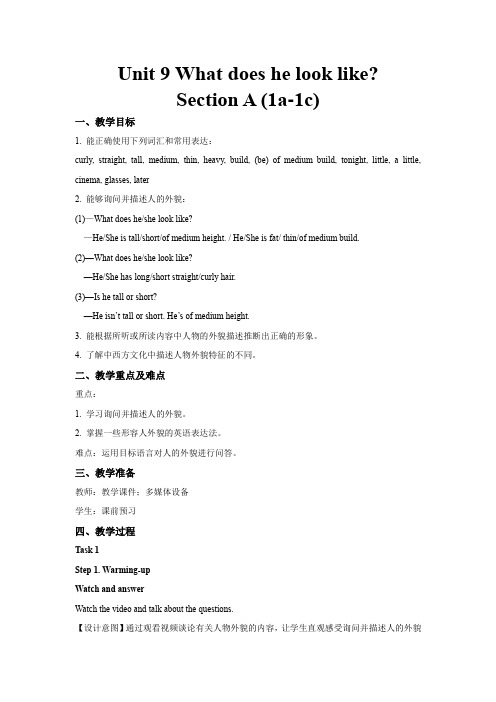
Unit 9 What does he look like?Section A (1a-1c)一、教学目标1. 能正确使用下列词汇和常用表达:curly, straight, tall, medium, thin, heavy, build, (be) of medium build, tonight, little, a little, cinema, glasses, later2. 能够询问并描述人的外貌:(1)—What does he/she look like?—He/She is tall/short/of medium height. / He/She is fat/ thin/of medium build.(2)—What does he/she look like?—He/She has long/short straight/curly hair.(3)—Is he tall or short?—He isn’t tall or short. He’s of medium height.3. 能根据所听或所读内容中人物的外貌描述推断出正确的形象。
4. 了解中西方文化中描述人物外貌特征的不同。
二、教学重点及难点重点:1. 学习询问并描述人的外貌。
2. 掌握一些形容人外貌的英语表达法。
难点:运用目标语言对人的外貌进行问答。
三、教学准备教师:教学课件;多媒体设备学生:课前预习四、教学过程Task 1Step 1. Warming-upWatch and answerWatch the video and talk about the questions.【设计意图】通过观看视频谈论有关人物外貌的内容,让学生直观感受询问并描述人的外貌的情景,顺利引入今天的主题。
Step 2. Pre-listeningLook and learn1.Let students look at the pictures and learn some new words and expressions this class.2.Let students try to describe their classmates using the new words and expressions, and others guess who he/she is.Other new words and expressionsShow some new words and expressions, ask students to try to read them and correct their pronunciations.【设计意图】让学生熟悉描述人的外貌特征的新词汇和表达法,为后面的学习做铺垫。
最新人教新目标英语七年级上册44页精品目标七公开课教学设计
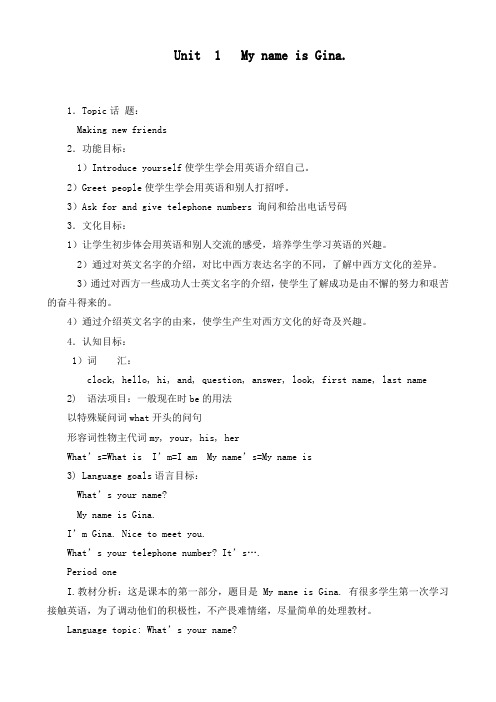
Unit 1 My name is Gina.1.Topic话题:Making new friends2.功能目标:1)Introduce yourself使学生学会用英语介绍自己。
2)Greet people使学生学会用英语和别人打招呼。
3)Ask for and give telephone numbers 询问和给出电话号码3.文化目标:1)让学生初步体会用英语和别人交流的感受,培养学生学习英语的兴趣。
2)通过对英文名字的介绍,对比中西方表达名字的不同,了解中西方文化的差异。
3)通过对西方一些成功人士英文名字的介绍,使学生了解成功是由不懈的努力和艰苦的奋斗得来的。
4)通过介绍英文名字的由来,使学生产生对西方文化的好奇及兴趣。
4.认知目标:1)词汇:clock, hello, hi, and, question, answer, look, first name, last name2) 语法项目:一般现在时be的用法以特殊疑问词what开头的问句形容词性物主代词my, your, his, herWhat’s=What is I’m=I am My name’s=My name is3) Language goals语言目标:What’s your name?My name is Gina.I’m Gina. Nice to meet you.What’s your telephone number? It’s….Period oneI.教材分析:这是课本的第一部分,题目是My mane is Gina. 有很多学生第一次学习接触英语,为了调动他们的积极性,不产畏难情绪,尽量简单的处理教材。
Lang uage topic: What’s your name?Language strategies: Talk about the namesMain vocabulary: name is, meet, his, first name, last name, answer, boy , girl.II.语言结构: present tense to be, what questions, Possessive adj. my, your, his, her. 。
最新人教版初中英语七年级上册Unit1MynameisGina.(公开课教学..
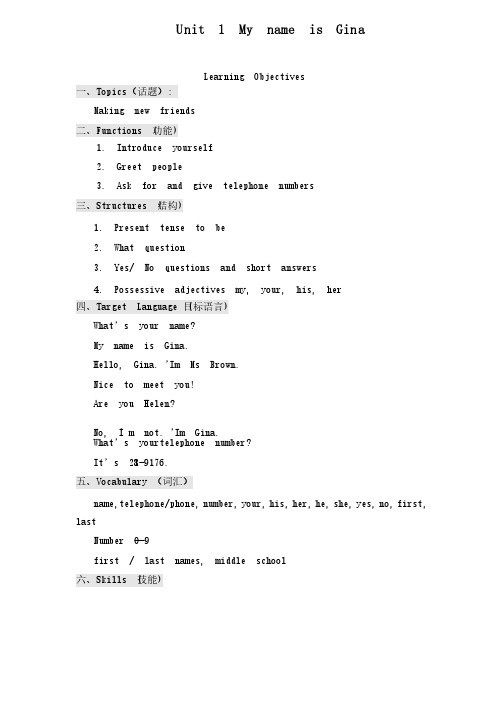
Unit 1 My name is GinaLearning Objectives一、一、Topics Topics Topics(话题)(话题)(话题): :Making new friends二、二、Functions (Functions (功能功能功能) ) 1. Introduce yourself2. Greet people3. Ask for and give telephone numbers三、三、Structures (Structures (结构结构结构) ) 1. Present tense to be2. What question3. Yes/ No questions and short answers4. Possessive adjectives my, your, his, her四、四、Target Language (Target Language (目标语言目标语言) )What’s your name?My name is Gina.Hello, Gina. I ’m Ms Brown.Nice to meet you!Are you Helen?No, I ’m not. I ’m Gina.What’s your t elephone number?telephone number? It’s 281-9176.1-9176. 五、五、Vocabulary Vocabulary(词汇) name,telephone/phone, number, your, his, her, he, she, yes, no, first, lastNumber 0—9first / last names, middle school六、六、Skills (Skills (技能技能技能) )Listening for key informationScanning in reading七、七、Recycling Recycling(复习巩固) Good morning! Hi/Hello! my, Alice, Bob, Cindy, Dale, Eric, Frank, Grace, Helen.八、教材分析本单元以greeting 和introduction 为话题,共设计了三个部分的内容。
最新外研版初中英语七年级上册My school公开课教学设计
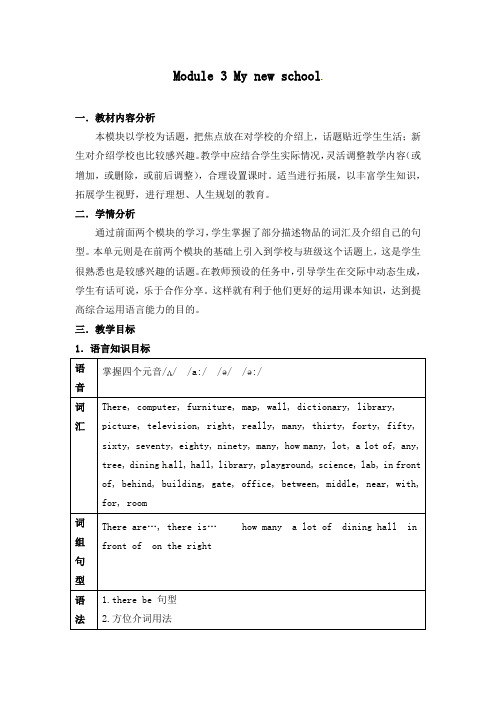
Module 3 My new school一.教材内容分析本模块以学校为话题,把焦点放在对学校的介绍上,话题贴近学生生活;新生对介绍学校也比较感兴趣。
教学中应结合学生实际情况,灵活调整教学内容(或增加,或删除,或前后调整),合理设置课时。
适当进行拓展,以丰富学生知识,拓展学生视野,进行理想、人生规划的教育。
二.学情分析通过前面两个模块的学习,学生掌握了部分描述物品的词汇及介绍自己的句型。
本单元则是在前两个模块的基础上引入到学校与班级这个话题上,这是学生很熟悉也是较感兴趣的话题。
在教师预设的任务中,引导学生在交际中动态生成,学生有话可说,乐于合作分享。
这样就有利于他们更好的运用课本知识,达到提高综合运用语言能力的目的。
三.教学目标1.语言知识目标语音掌握四个元音/ʌ/ /a:/ /ə/ /ə:/词汇There, computer, furniture, map, wall, dictionary, library, picture, television, right, really, many, thirty, forty, fifty, sixty, seventy, eighty, ninety, many, how many, lot, a lot of, any, tree, dining h all, hall, library, playground, science, lab, in front of, behind, building, gate, office, between, middle, near, with, for, room词组句型There are…, there is… how many a lot of dining hall in front of on the right语法1.there be 句型2.方位介词用法功能介绍学校的设施。
话题以学生和学校为中心,以介绍学校的设施为话题。
2021七年级英语下册教学设计教案5篇七年级英语教学设计教
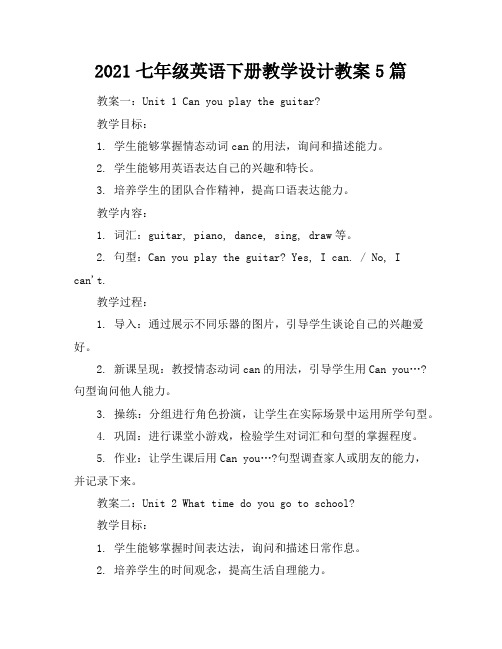
2021七年级英语下册教学设计教案5篇教案一:Unit 1 Can you play the guitar?教学目标:1. 学生能够掌握情态动词can的用法,询问和描述能力。
2. 学生能够用英语表达自己的兴趣和特长。
3. 培养学生的团队合作精神,提高口语表达能力。
教学内容:1. 词汇:guitar, piano, dance, sing, draw等。
2. 句型:Can you play the guitar? Yes, I can. / No, Ican't.教学过程:1. 导入:通过展示不同乐器的图片,引导学生谈论自己的兴趣爱好。
2. 新课呈现:教授情态动词can的用法,引导学生用Can you…?句型询问他人能力。
3. 操练:分组进行角色扮演,让学生在实际场景中运用所学句型。
4. 巩固:进行课堂小游戏,检验学生对词汇和句型的掌握程度。
5. 作业:让学生课后用Can you…?句型调查家人或朋友的能力,并记录下来。
教案二:Unit 2 What time do you go to school?教学目标:1. 学生能够掌握时间表达法,询问和描述日常作息。
2. 培养学生的时间观念,提高生活自理能力。
教学内容:1. 词汇:o'clock, usually, often, always等。
2. 句型:What time do you go to school? I usually go to school at 7 o'clock.教学过程:1. 导入:通过谈论学生的日常作息,引导学生关注时间表达。
2. 新课呈现:教授时间表达法,引导学生用What time do you…?句型询问他人作息。
3. 操练:分组进行对话练习,让学生在实际场景中运用所学句型。
4. 巩固:进行课堂小游戏,检验学生对词汇和句型的掌握程度。
5. 作业:让学生课后记录自己一周的作息时间,并用所学句型进行描述。
【公开课教案】仁爱英语七上Unit 3 Topic 1 Section C
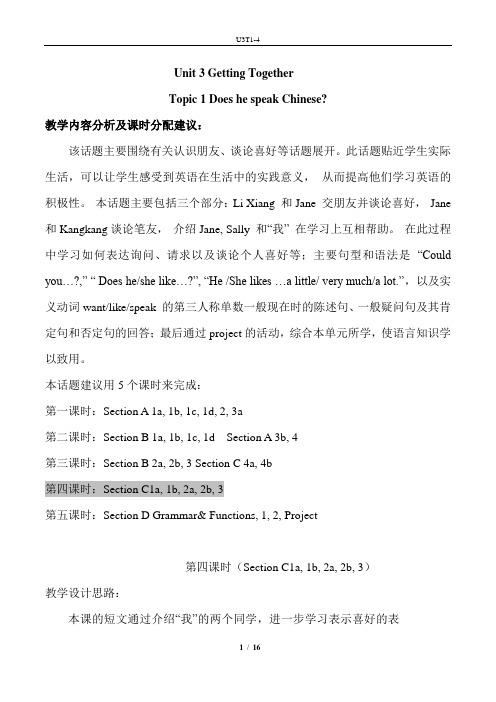
Unit 3 Getting TogetherTopic 1 Does he speak Chinese?教学内容分析及课时分配建议:该话题主要围绕有关认识朋友、谈论喜好等话题展开。
此话题贴近学生实际生活,可以让学生感受到英语在生活中的实践意义,从而提高他们学习英语的积极性。
本话题主要包括三个部分:Li Xiang 和Jane 交朋友并谈论喜好,Jane 和Kangkang谈论笔友,介绍Jane, Sally 和“我” 在学习上互相帮助。
在此过程中学习如何表达询问、请求以及谈论个人喜好等;主要句型和语法是“Could you…?,” “ Does he/she like…?”, “He /She likes …a little/ very much/a lot.”,以及实义动词want/like/speak 的第三人称单数一般现在时的陈述句、一般疑问句及其肯定句和否定句的回答;最后通过project的活动,综合本单元所学,使语言知识学以致用。
本话题建议用5个课时来完成:第一课时:Section A 1a, 1b, 1c, 1d, 2, 3a第二课时:Section B 1a, 1b, 1c, 1d Section A 3b, 4第三课时:Section B 2a, 2b, 3 Section C 4a, 4b第四课时:Section C1a, 1b, 2a, 2b, 3第五课时:Section D Grammar& Functions, 1, 2, Project第四课时(Section C1a, 1b, 2a, 2b, 3)教学设计思路:本课的短文通过介绍“我”的两个同学,进一步学习表示喜好的表达法。
首先通过头脑风暴的方式复习了第三人称单数的一般现在时,为本课学习做铺垫。
通过引入学生喜欢的明星导入本课的重难点,即like…a little, like…a lot/very much, doesn’t like at all.然后让学生结合实际生活,谈论对英语和语文学科的喜好,及时进行复习巩固,同时也训练学生将图表信息转化为口头表达的能力。
Unit 1 My name’s Gina第3课时公开课教学设计【人教版英语七年级上册】

Unit 1 My name’s Gina.Section B 1a—2c教学设计一、教学目标1. 能掌握以下单词和短语:zero—nine, telephone, number, phone, first name, last name, friend, middle school, China等。
2. 能掌握以下句型:(1) —What’s your/his/her telephone number?—It’s …(2) —What’s your first/last name?—My first/last name is …(3) —What’s his/her first/last name?—His / Her first/last name is …3. 能辨别英文中的姓氏与名字,了解中英文中姓名之间的区别。
4. 能听懂日常对话,并且能够从听力训练中获取常见人名和电话号码的信息。
5. 能读懂介绍个人信息的文章,并且能够按要求提取关键信息。
6. 帮助学生比较中英文姓名的不同之处,通过了解中英文名字的区别,培养和提高学生对中外文化差异的敏感性和鉴别能力,加深对本国文化的理解和认识,培养学生的世界观意识,以及初步的跨文化交际能力。
二、教学重点及难点重点:1. 能掌握以下单词和短语:zero—nine, telephone, number, phone, first name, last name, friend, middle school, China等。
2. 能掌握以下句型:(1) —What’s your/his/her telephone number?—It’s …(2) —What’s your first/last name?—My first/last name is …(3) —What’s his/her first/last name?—His / Her first/last name is …3. 能辨别英文中的姓氏与名字,了解中英文中姓名之间的区别。
Unit 7 Section A 第1课时示范公开课教案【英语人教新目标七上】

Unit 7 How much are the socks?Section A (1a—2d)教学设计一、教学目标1. 能够熟练掌握本课重点词汇和短语:much, sock, T-shirt, sweater, trousers, shoe, shirt, dollar, pair, big, small, short, long, how much, a pair of2. 熟练掌握本课重点句型:(1) —How much is this T-shirt?—It’s seven dollars.(2) —How much are these socks?—They’re two dollars.3. 能够听懂谈论衣物价格、颜色和大小的对话内容,并从中获取关键信息。
4. 能够运用How much …? 句型谈论物品的价格。
5. 能够了解常见的货币单位和移动支付模式。
二、教学重点及难点重点:1. 能够听懂有关谈论衣物价格、颜色和大小的对话内容,并从中获取关键信息。
2. 能够运用How much …? 句型谈论物品的价格。
难点:能够运用How much …? 句型谈论物品的价格。
三、教学过程四、板书设计Unit 7 How much are these socks?第1课时Section A (1a—2d)1. Key words: much, sock, T-shirt, sweater, trousers, shoe, shirt, dollar, big, small, short, long, pair, how much, a pair of2. Key sentences:(1) —How much is this T-shirt?—It’s seven dollars.(2) —How much are these socks?—They’re two dollars.。
Unit 1 Lesson 3 示范公开课教学设计【七年级英语上册(冀教版)】

Unit 1 Schools and Friends Lesson 3 Welcome to Our School教学设计一、教学目标1. 掌握本课重点词汇和短语:visiting, show, around, classroom, office, plan, fun, lab, visiting student, show...around, have lessons, play sports, have fun2. 掌握本课重点句型:Welcome to our school.He is a visiting student in Li Ming’s school.Let me show you around.We play sports and have fun there.3. 能够听懂关于介绍学校设施和活动的语篇内容,培养学生预测和获取细节信息的能力。
4. 能够运用有关介绍学校设施和活动的语言和结构,画出并介绍学校的设施。
5. 能够有礼貌地带领他人参观学校。
二、教学重难点重点:1. 掌握本课重点词汇和短语:visiting, show, around, classroom, office, plan, fun, lab2. 掌握本课重点句型:Welcome to our school.He is a visiting student in Li Ming’s school.Let me show you around.We play sports and have fun there.3. 能够听懂关于介绍学校设施和活动的语篇内容,培养学生预测和获取细节信息的能力。
难点:能够运用有关介绍学校设施和活动的语言和结构,画出并介绍学校的设施。
三、教学过程Step 1 Warming-upGuide Ss to describe their school according to the following questions.(1)What is in your school?(2)What do you do there?【设计意图】结合本课主题,通过让学生介绍自己的学校,自然地进入情境,开始本课时的学习。
七年级英语教学设计详细教案(精选7篇)
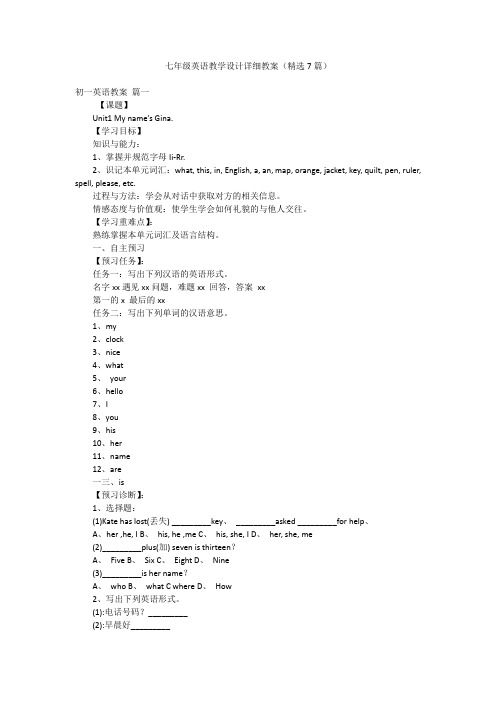
七年级英语教学设计详细教案(精选7篇)初一英语教案篇一【课题】Unit1 My name’s Gina.【学习目标】知识与能力:1、掌握并规范字母Ii-Rr.2、识记本单元词汇:what, this, in, English, a, an, map, orange, jacket, key, quilt, pen, ruler, spell, please, etc.过程与方法:学会从对话中获取对方的相关信息。
情感态度与价值观:使学生学会如何礼貌的与他人交往。
【学习重难点】:熟练掌握本单元词汇及语言结构。
一、自主预习【预习任务】:任务一:写出下列汉语的英语形式。
名字xx遇见xx问题,难题xx 回答,答案xx第一的x 最后的xx任务二:写出下列单词的汉语意思。
1、my2、clock3、nice4、what5、your6、hello7、I8、you9、his10、her11、name12、are一三、is【预习诊断】:1、选择题:(1)Kate has lost(丢失) _________key、_________asked _________for help、A、her ,he, IB、his, he ,meC、his, she, ID、her, she, me(2)_________plus(加) seven is thirteen?A、FiveB、SixC、EightD、Nine(3)_________is her name?A、whoB、what C where D、How2、写出下列英语形式。
(1):电话号码?_________(2):早晨好_________(3):下午好_________3、写出下列词的英语意思:1)、早晨_________2)、下午_________3)、晚上_________4)、谢谢_________5)、名字_________6)、好的_________or_________【预习反思】:你还有什么问题吗?(Do you have any problems?)二、课中实施Step1 交流展示Step2 精讲点拨:What’s your name?你叫什么名字?句中的your可根据问对象换成his、her等物主代词。
仁爱版七年级英语上册Unit3Topic3SectionC优秀教学案例
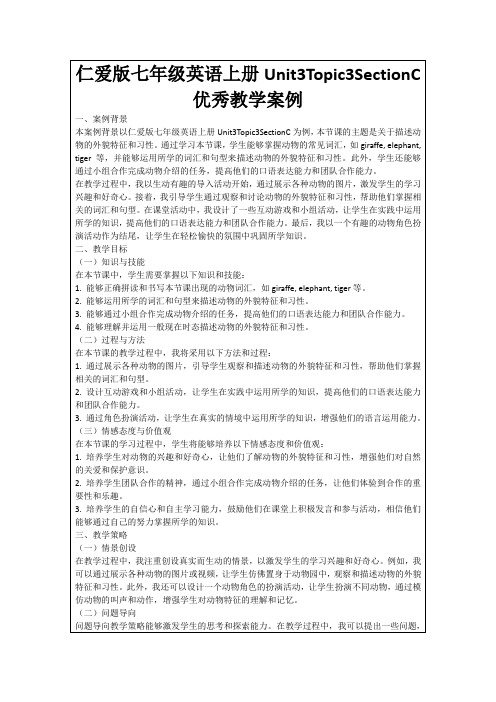
仁爱版七年级英语上册Unit3Topic3SectionC优秀教学案例
一、例背景
本案例背景以仁爱版七年级英语上册Unit3Topic3SectionC为例,本节课的主题是关于描述动物的外貌特征和习性。通过学习本节课,学生能够掌握动物的常见词汇,如giraffe, elephant, tiger等,并能够运用所学的词汇和句型来描述动物的外貌特征和习性。此外,学生还能够通过小组合作完成动物介绍的任务,提高他们的口语表达能力和团队合作能力。
2.问题导向:在教学过程中,教师提出了一系列问题,引导学生思考和讨论动物的外貌特征和习性。这有助于培养学生的批判性思维能力和解决问题的能力,使他们能够更好地理解和掌握所学知识。
3.小组合作:通过组织学生进行小组讨论和合作完成动物介绍的任务,本案例有效地培养了学生的团队合作能力和口语表达能力。学生在小组内部进行交流和合作,共同完成任务,提高了他们的沟通和协作能力。
(四)反思与评价
反思与评价是教学过程中不可或缺的一环。在教学结束时,我可以让学生进行自我反思和评价,思考他们在课堂上的学习情况和进步。此外,我还可以组织学生进行小组评价,让他们相互交流和分享彼此的学习心得和经验。通过反思与评价,学生可以更好地了解自己的学习情况,发现自己的不足之处,从而激发他们继续学习和进步的动力。
3.培养学生的自信心和自主学习能力,鼓励他们在课堂上积极发言和参与活动,相信他们能够通过自己的努力掌握所学的知识。
最新人教新目标英语七年级上册Unit 4 第1课时公开课教学设计

Unit 4 Where’s my schoolbag?一、教材分析本单元围绕着Where is my schoolbag?的话题,共设计了三个部分的内容。
通过教授本单元,使学生学会谈论房间里物品的位置,能读懂有关物品位置的便条,并学会写便条让朋友帮自己从房间里取东西。
Section A 让学生通过活动,学习如何表达物品的位置,并能就物品位置进行提问。
1a, 1b, 1c 学习表示物品的名词,并能物品的位置进行问答。
重点运用where 特殊问句进行谈论。
二、三维目标1. Language goals:Key vocabulary: table, bed, bookcase, sofa, chair, where, on, under. Target language: Where’s my schoolbag? It’s under the table.Where are my books? They’re on the sofa2. Ability goalsTalk about where things are, Learn the using of preposition “ on, in, under”Train the students’ communicative competence.3. Moral goalsKeep your room and tidy.三、教学重点1、熟练运用Where问句和一般疑问句及其回答。
2.掌握名词单复数及人称代词they的用法。
四、教学难点一般疑问句Is it…? Are they…?的回答。
五、教学策略注重因材施教,对基础不同的学生,在开始阶段应有不同层次的要求,多鼓励,少批评,甚至不批评,以充分调动每个学生学习英语的积极性四、教学准备ppt ,多媒体课件等教学资料。
五、教学环节1、课堂导入students play a chantThis is a pen. These are pens.That is a book Those are booksIt’s a key They’re keys2、课堂讲授Learn the new wordsShow the pictures of the things on the screen.Teach the new words: chair, table, bed ,bookcase, sofa.(First, read the pronunciations , then read the words. Each word has the singular form and plural form.)Read the words over and over again until the students can name each item fluently.3、课堂练习exercise(用is/are填空)(1)Where _____ my schoolbag? (2) Where _____ my books?(3)Lily’s schoolbag ______ under the desk.(4) Tom’s books ______ on the sofa.(5)They ____ under the table. (6)It _____ a key4、课堂活动Work on 1aT: Turn to page 19, look at 1a. First read the words. Then look at the picture and look at the letters.Read the instruction. Students do 1a on their own.Check the answers.Read the words again.5、课堂小结采用“任务型”教学方法,遵循“任务”的递进原则,从单词到句型再到语法,逐步在设计教学活动,活动都有明确的目的和可操作性。
七年级英语上册Module-10-Unit-2公开课优秀教学设计

Module 10 Unit 2Teaching content: Unit 2: My mother’s cleaning our houseTeaching aims:①Knowledge aim: enable students to master the phrases and words: In February; in January; sweep away; celebrate, clean the house; a traditional family dinner.②Ability aim: enable students to understand and talk about the celebration of Spring Festival.③Emotion aim: enable students to get to know and inherit our traditional culture.Teaching key and difficult points: To make students master the reading skills; enable students to talk about Spring Festival.Teaching and learning methods: task-based reading; PWP approachingTeaching aids/ preparation: PPT works.Teaching procedures:Step I: Pre-reading (Warming up )Revision:Work in pairs.look at the pictures and talk about what’shappening.(Activity 1, page 62)Available phrases: clean the house; have family dinner; visit relatives.Sentence structure: —What’s sb.Doing?—He / She /Sb.is doing sth.Step II:While-reading1.Fast readingStudents read the passage for the first time quickly and find out the answers tothe following questions:When does the Spring Festival come?What does “lucky money” mean?Before the group work, teacher guides to explain the structure of this passage (Writing skill——time order)①Match the paragraphs with pictures in Activity 1.3.Presentation and explanation of the language points.Students listen and read the passage, try to understand and translate it by themselves; at the same time, they are asked to underline sentences or phrases they can’t understand.After that, thee teacher explains language points in this passage.Step III: Post-readingSummary: teacher and students work together to retell the passage according to the key wors.(Table in detailed reading):a few days before Spring Festival→ on the eveningbefore Spring Festival→ during the Spring Festival.1.Teacher: the Spring Festival is a Chinese traditional festival, and it’s the mostimportant festival, we should keep its excellent traditions and inherit them. Homework: talk about your Spring Festival and write an article about it.(You can imitate the text)。
Unit 5 Lesson 28公开课教学设计【七年级英语上册(冀教版)】

Unit 5 Family and homeLesson 28 A family picnic教学设计◆教材分析本课时的教学内容是冀教版七年级上册英语第五单元的第四课时,重点在于引导学生理解语境,从“野餐”开始,自然地导入一家人去野餐的话题。
以如何野餐作为任务引起学生的听说兴趣,训练学生的听力和口语表达能力。
利用实物或图片学习英语单词,同时在对话中反复运用新学的单词和短语。
因此,教师可以将知识目标定为掌握本课时新出现的词和短语,如何在户外野餐的句型。
情感目标定为通过话题的学习,培养学生的学习习惯和兴趣,使学生能够听懂和写关于野餐的短文。
◆教学目标【知识与能力目标】掌握单词: picnic, carry, basket, lot, quiet短语: go on a picnic, a basket of…, lots of…, look out, etc.【过程与方法目标】Listening and speaking【情感态度价值观目标】了解在国外家人一起野餐的情况。
◆教学重难点◆【教学重点】能使用现在进行时。
【教学难点】能听懂关于野餐的短文,能说出英语国家中常见的饮料与食品的名称。
◆课前准备图片,PPT◆教学过程Step 1. Lead inLeading in 【情景1】Warm up:A free talk about the picnic. The teacher asks the students something about the picnic.T: Do you have a picnic?S1: No, but I want to go for a picnic.T: What will you bring for a picnic?S1: Let me see. I will bring some vegetables, such as carrots, cabbage, cucumbers and so on.T: Very good. Sit down please. (To another student) What will you bring for a picnic?S2: I like fruits. I will bring apples,bananas, pears and oranges.T: Good.I like fruits too. But my favourite food is meat. And I think I will bring some drinks or water.【设计意图】利用学生学过的内容,从“野餐带什么”开始,轻松进入语境,让孩子们把和野餐有关的词汇、短语和句型温习一下。
初中英语七年级lesson1教学设计

初中英语七年级lesson1教学设计一、教学目标1.知识目标:掌握基本单词和句型,能够进行简单的英语对话。
2.能力目标:培养学生听说读写的基本英语能力,提高学生英语交际能力。
3.情感目标:培养学生对英语的兴趣和热爱,增强学生学习英语的自信心。
二、教学内容1.单词:学习本课新单词,包括名词、动词、形容词等。
2.句型:掌握基本句型,如“What’s your name?”,“How are you?”等。
3.对话:通过角色扮演、对话等方式进行口语练习,提高学生英语交际能力。
4.阅读:阅读英语小故事或短文,提高学生阅读理解能力。
三、教学重点1.掌握本课新单词和句型。
2.能够熟练运用基本句型进行英语对话。
3.提高学生英语听说读写的能力。
四、教学难点1.纠正学生的发音问题,帮助学生掌握正确的发音方法。
2.提高学生英语口语表达能力,培养学生在实际场景中运用英语的能力。
3.帮助学生理解英语语法规则,使学生能够正确使用英语语法。
五、教学方法1.讲授法:通过教师讲解新单词和句型,帮助学生掌握基础知识。
2.互动法:通过角色扮演、对话等方式进行口语练习,增强师生之间和学生之间的互动交流。
3.游戏法:通过设计有趣的英语游戏,增强学生学习英语的兴趣和参与度。
4.演示法:通过教师示范和学生演示,帮助学生掌握正确的英语发音和口语表达能力。
5.探究法:通过引导学生自主探究,培养学生的自主学习能力和解决问题的能力。
6.小组合作法:通过小组合作的方式进行学习和交流,培养学生的合作意识和协作能力。
7.个性化指导法:针对不同学生的需求和问题,进行个性化的指导和帮助,帮助学生更好地掌握英语知识和技能。
8.教学媒体运用:利用多媒体教学工具,如PPT、音频、视频等,辅助教学进程,提高教学效果。
9.课堂评价与反馈:在教学过程中及时进行评价和反馈,帮助学生了解自己的学习情况并进行调整改进。
同时向家长反馈学生的学习情况,增强家校互动与合作。
10.课外辅导与拓展:通过课外辅导和拓展活动,如英语角、英语电影欣赏等,帮助学生巩固所学知识并拓展视野。
七年级上册英语市公开课获奖教案省名师优质课赛课一等奖教案初中
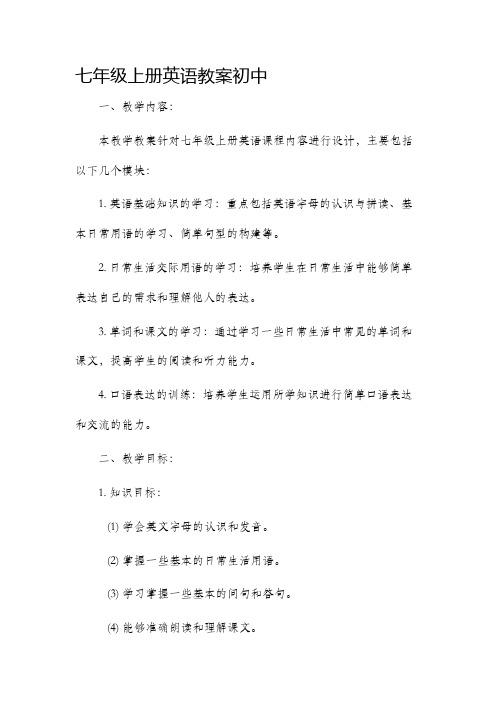
七年级上册英语教案初中一、教学内容:本教学教案针对七年级上册英语课程内容进行设计,主要包括以下几个模块:1. 英语基础知识的学习:重点包括英语字母的认识与拼读、基本日常用语的学习、简单句型的构建等。
2. 日常生活交际用语的学习:培养学生在日常生活中能够简单表达自己的需求和理解他人的表达。
3. 单词和课文的学习:通过学习一些日常生活中常见的单词和课文,提高学生的阅读和听力能力。
4. 口语表达的训练:培养学生运用所学知识进行简单口语表达和交流的能力。
二、教学目标:1. 知识目标:(1) 学会英文字母的认识和发音。
(2) 掌握一些基本的日常生活用语。
(3) 学习掌握一些基本的问句和答句。
(4) 能够准确朗读和理解课文。
(5) 能够运用学到的中文翻译英文,并能进行简单的口语表达。
2. 能力目标:(1) 提高学生的听说能力,尤其是对于日常英语的听力和口语表达。
(2) 培养学生的自主学习和合作学习的能力。
3. 情感目标:(1) 培养学生对英语学习的兴趣和自信心。
(2) 培养学生的团队合作精神和互助精神。
三、教学重难点:1. 重点:英语字母的学习与发音、常用日常表达用语的学习。
2. 难点:掌握课文的理解和运用、口语表达能力的提高。
四、教学过程:1. 创设情境导入教学:通过播放英文儿歌或操练英语对话,引发学生的学习兴趣。
2. 学习英语字母的认知与发音:(1) 学习英语字母的名称和发音,通过游戏或儿歌进行学习。
(2) 练习英语字母的连写和书写。
3. 学习日常生活交际用语:(1) 学习基本的问候语和自我介绍。
(2) 学习询问别人的基本信息。
(3) 学习表示感谢和道歉的表达方式。
4. 掌握问句和答句的基本句型:(1) 学习一些基本的问句,如What's your name? How are you?等。
(2) 学习简单的答句,如I'm fine, thank you.等。
5. 课文学习与理解:(1) 阅读课文并默写,加深对课文内容的理解。
关于七年级英语教学设计(通用7篇)

关于七年级英语教学设计(通用7篇)七年级英语教学设计(通用7篇)作为一位兢兢业业的人民教师,编写教学设计是必不可少的,教学设计是教育技术的组成部分,它的功能在于运用系统方法设计教学过程,使之成为一种具有操作性的程序。
那么教学设计应该怎么写才合适呢?下面是小编为大家整理的关于七年级英语教学设计(通用7篇),供大家参考借鉴,希望可以帮助到有需要的朋友。
七年级英语教学设计1一、教学目标:1、掌握There be 结构所表达的意义。
2. 掌握There be 结构的一般现在时和一般过去时基本句式。
3. 掌握There be 结构的回答方式。
二、重点难点there be 句型的'肯定式、否定式一般疑问句及其回答方式。
There be句型和havehas的区别三、教学方法:讲授法、分组讨论法、任务型教学法、多媒体教学四、教学过程(一)、there be构成There be ...句型,表示的是“某地或某时有某人或某物”,其结构为There be(is,are,was, were )+某物 / 某人 + 某地 / 某时。
(二)、There be 结构的一般现在时和一般过去时各种句式。
(1)肯定式There is a supermarket on that road.在那条路上有一个超市。
There was a supermarket on that road last year.去年在那条路上有一个超市。
There are many people here on vacation.有很多人在这里度假。
There were many people here on vacation last summer. 去年夏季有很多人在这里度假。
(2)否定式There be句型否定句式的构成和含有be动词的其它句型一样,在be后加上“not”。
例如:There isn`t a supermarket on that road.在那条路上没有超市。
初中英语教学设计【优秀14篇】
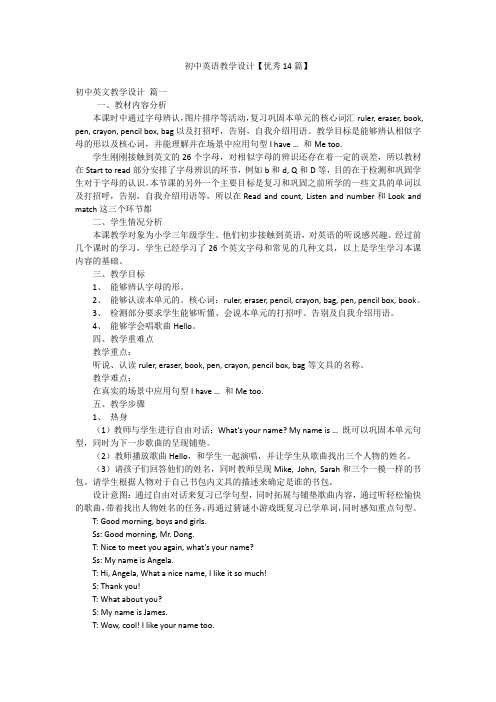
初中英语教学设计【优秀14篇】初中英文教学设计篇一一、教材内容分析本课时中通过字母辨认,图片排序等活动,复习巩固本单元的核心词汇ruler, eraser, book, pen, crayon, pencil box, bag以及打招呼,告别,自我介绍用语。
教学目标是能够辨认相似字母的形以及核心词,并能理解并在场景中应用句型I have … 和Me too.学生刚刚接触到英文的26个字母,对相似字母的辨识还存在着一定的误差,所以教材在Start to read部分安排了字母辨识的环节,例如b和d, Q和D等,目的在于检测和巩固学生对于字母的认识。
本节课的另外一个主要目标是复习和巩固之前所学的一些文具的单词以及打招呼,告别,自我介绍用语等,所以在Read and count, Listen and number和Look and match这三个环节都二、学生情况分析本课教学对象为小学三年级学生。
他们初步接触到英语,对英语的听说感兴趣。
经过前几个课时的学习,学生已经学习了26个英文字母和常见的几种文具,以上是学生学习本课内容的基础。
三、教学目标1、能够辨认字母的形。
2、能够认读本单元的。
核心词:ruler, eraser, pencil, crayon, bag, pen, pencil box, book。
3、检测部分要求学生能够听懂、会说本单元的打招呼、告别及自我介绍用语。
4、能够学会唱歌曲Hello。
四、教学重难点教学重点:听说、认读ruler, eraser, book, pen, crayon, pencil box, bag等文具的名称。
教学难点:在真实的场景中应用句型I have … 和Me too.五、教学步骤1、热身(1)教师与学生进行自由对话:What’s your name? My name is … 既可以巩固本单元句型,同时为下一步歌曲的呈现铺垫。
(2)教师播放歌曲Hello,和学生一起演唱,并让学生从歌曲找出三个人物的姓名。
- 1、下载文档前请自行甄别文档内容的完整性,平台不提供额外的编辑、内容补充、找答案等附加服务。
- 2、"仅部分预览"的文档,不可在线预览部分如存在完整性等问题,可反馈申请退款(可完整预览的文档不适用该条件!)。
- 3、如文档侵犯您的权益,请联系客服反馈,我们会尽快为您处理(人工客服工作时间:9:00-18:30)。
猜一猜活动,猜谜游戏活跃课堂氛围,进一步巩固重点词汇与句子,让学生在具体的情景中来掌握新句型。
Step5:Match the words in the book and listen to tapes
Activity 1:Match the words
创设情境,在已有知识的基础上,引入新的句型结构。多次机械呈现练习,使学生熟悉掌握目标语言。
Step10:Homework
了解你和你家人所喜欢的食物。你和你家人都喜欢什么呢?赶快去问问他们吧!
Write down the homework and finish it after class.
课后复习巩固本课所学的重点词汇和重点句型。
Step1:Greetings
Greet with the students:
“Good morning, everyone!”
How are you?
Nice to meet you
“Good morning!Ms Zhang !’’
I’m fine,thanks
Nice to meet you,too
让学生快速进入课堂。
Step 2:Warming-up
Get the student to watch a picture :
Who are they?
The students look at the picture:
They are GTQ.
观看“熊出没”图片,活跃课堂气氛,并通过图片引出本节课的话题,为接下来的学习做铺垫
教学
Байду номын сангаас方法
在老师的引导下,以自主探究学习和小组合作学习为主,学生通过老师设计的各个活动,学习理解生词重点句型。在此基础上,通过听,说各个课堂活动,并且以小组合作学习交流的方式进行。最后给以归纳总结并结合相关的习题加强巩固。
教学
手 段
多媒体课件
教 学 步 骤
教学环节
教 师 活 动
预设学
生行为
设 计 意 图
T: Does she/he like bananas?
Help them to answer like this:
Ss: Yes, she/he does./No, she/he doesn’t.
Then practice like that many times.
Ss:Yes, she/he does./No, she/he doesn’t.
Step7:
Summary
Show some pictures and teach:
She likes apples, but she doesn’t like bananas.
He likes oranges, but he doesn’t like tomatoes.
Then ask all the other students
Then get the student toknowthe point about the countable nouns and the uncountable nouns.
Get the ss to finish 1a, then check the answers together.
The students listen carefully and answer the questions.
The students
do the match exercises carefully.
图片直观呈现,教授食物新词汇,并通过直观的图片教学可数名词和不可数名词。
词汇检测口头练习,巩固新授词汇。
Step4:Guess
Get the students to guess the words: apple,practice“Do you like bananas?”Yes,I do........
训练学生眼力与听力,在英语的氛围中巩固本单元知识点
Step6:Practice
Activity:Pair-work
Suppose students are in the supermarket with their friends,talking about something about what we learned in this class
Step3:Presentation
Show some pictures, teach the new words about fruit by asking“what is this inEnglish?What are these?”
Get the students to answer“It
is a…/They are…
The students work in pairs, pratice the dialogue.
The students
work actively and happily
利用给出的图画问同伴对食物的喜好,操练巩固新单词及目标语言。
通过小组活动,口头操练目标语言,同时培养学生的团结协作意识,调动学生的学习热情和参与意识。使学生把所学学以致用。鼓励学生用本节课所学的重点句型询问自己好朋友对事物的喜好。提高学生的积极性,愉悦课堂氛围和学生的情感。巩固知识点,提高综合语言运用能力。
3.情感目标:讨论美食,享受生活美味,提倡健康合理膳食。
教
学
重
点
掌握关于食物的词汇。
教学
难点
学会使用以下用语讨论:
Do you like bananas? Yes, I do./No, Idon’t.
Does she/he like…?Yes, she/he does.She/he likes…
No, she/he doesn’t like...
人教版七年级英语上册 Unit 6 Do you like bananas ?教学设计
红光学校 张成英
学 科
初中
英语
教材
版本
人教版
年级
七年级
册别
上 册
章节
Unit6 period 1
课 题
Do you like bananas?
教
学
目
标
教学目标
1.知识目标:
(1)单词:strawberry,hamburger, orange, tomato, ice-cream, salad, banana,milk,pear,do, don’t, does, doesn’t, like,
(2)句型:Do you like …?Yes, I do. Ilike…/ No, I don’t. Idon’t like…
Does she/he like…?Yes, she/he does.She/he likes…/No, she/he doesn’t like...、
2.能力目标:通过学习本课,学生能够用英语互相讨论喜欢与不喜欢的食品。
Activity 2:Listen to the tapes
Then show the answers
The students answers match the words one by one.
The students listen to the tapescarefully and write down the orders.
板书设计
Unit 6 Doyoulikebananas?
--Doyou like bananas?
--Yes, Ido.Ilike bananas.
No, Idon’t.Idon’tlikebananas.
